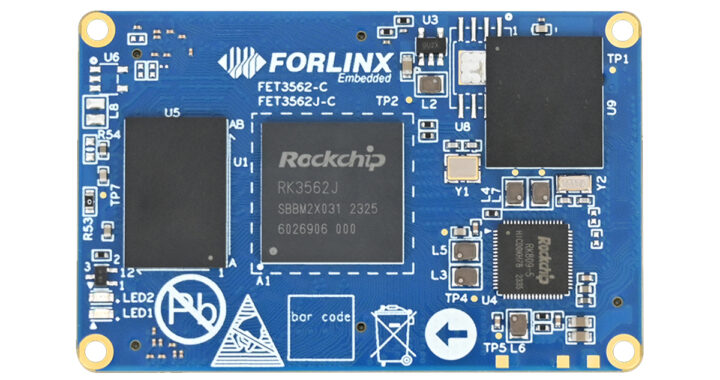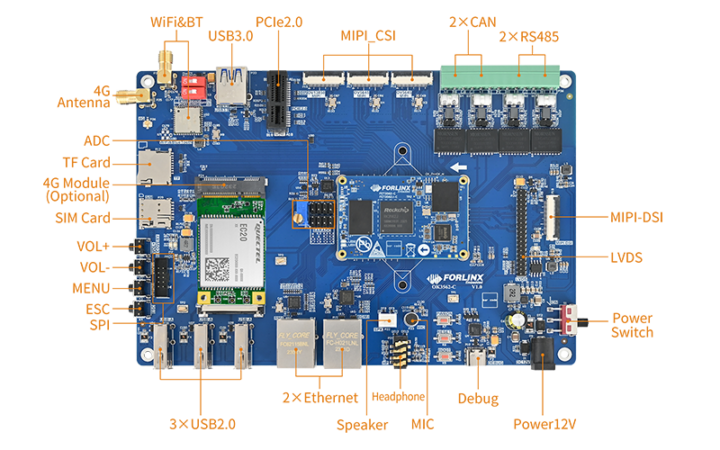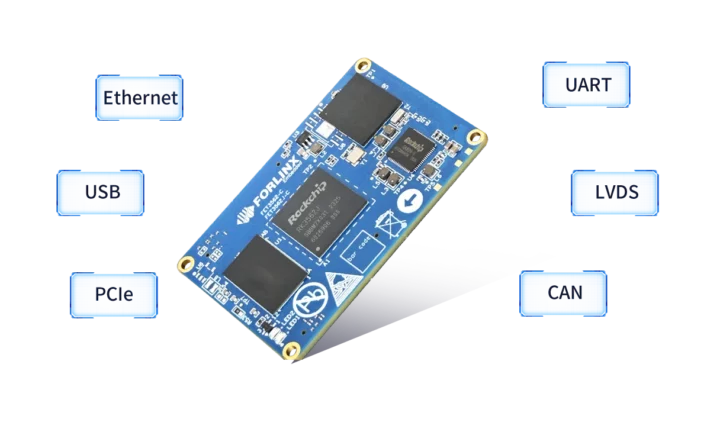The Forlinx FET3562J-C is a Rockchip RK3562/RK3562J powered System-on-Module (SoM) built with a 22nm process and features four high-performance ARM Cortex-A53 cores running at up to 2GHz. It also can support up to 2GB LPDDR4 RAM and can be configured with up to 16GB eMMC storage. Additionally, it has 1 TOPS NPU and standard peripherals like Ethernet, Wifi, Bluetooth, LVDS, MIPI DSI, and much more. All these features make this SoM useful for IoT, automation, and consumer electronic applications.
Previously, we have seen Forlinx launch similar SoM with development boards such as the Forlinx RZ/G2L, the FET-MX9352-C, the OK335xS-II and much more feel free to check those out if you are interested in the topic.
Forlinx FET3562J-C SoM and carrier board specifications
- SoM Specifications
- SoC (one or the other)
- Rockchip RK3562J – ARM Cortex-A53 quad-core @ 1.8GHz
- Rockchip RK3562
- ARM Cortex-A53 quad-core @ 2.0 GHz
- NPU – 1 TOPS INT8
- GPU – Mali-G52-2EE, supports OpenGL ES 1.1/2.0/3.2, OpenCL 2.0, Vulkan 1.0/1.1
- VPU
- Hard encode – H.264 @ 1920×1080@60fps
- Hard decode – H.265, VP9 @ 4096×2304@30fps; H.264 @ 1920×1080@60fps
- RAM – 1GB/2GB LPDDR4
- Storage – 8GB/16GB eMMC flash
- 3x 80-pin board-to-board connectors (0.5mm pitch, combined height 2.0mm)
- Storage – SDIO 3.0 with 4-bit data width
- Display
- MIPI DSI – 1x TX, 4 lanes, up to 2048×1080@60Hz
- LVDS – VESA/JEIDA, up to 800×1280@60Hz
- RGB – RGB888, up to 2048×1080@60Hz
- Camera (Can support up to 4 CSI inputs together)
- Two ports including MIPI_CSI_RX0 and MIPI_CSI_RX1 are available;
- A single port supports 4-lane with each lane up to 2.5Gbps;
- A single port can be split into 2x 2-lane
- Audio
- Built-in Codec – 48kHz-192kHz, 1.3W speaker, stereo output, 2 mics
- SAI – 3 interfaces (1 used by codec), I2S/PCM/TDM, 8-32 bit, 192 kHz
- PDM – 8 channels, 192 kHz
- SPDIF – 16/20/24-bit, stereo output, linear/non-linear PCM
- Ethernet – 1x RGMII (10/100/1000Mbps), 1x RMII (10/100Mbps)
- USB
- 1 x USB2.0 Host
- 1x USB3.0 Host/Slave (multiplexed with PCIe2.1)
- Other Interfaces
- UART – Up to 10 UARTs, support various serial data transfer modes and flow control
- CAN – 2 x CAN2.0B, 1Mbps
- SPI – Up to 3 ports, supports host/slave mode
- I2C – Up to 5 ports, supports standard and high-speed modes
- PWM – 16 on-chip PWMs with interrupt operation
- ADC – 16 channels, 10-bit SARADC, sampling rate up to 1MS/s
- GPIO – Up to 79 pins, multiplexed
- PCIe – PCIe2.1, single-channel, 5Gbps
- Power – 5V DC
- Operating temperature
- Rockchip RK3562J – -40 to +85 (industrial grade)
- Rockchip RK3562 – 0 to +70 (commercial grade)
- Dimensions – 56 x 36 x 4.8 mm
- SoC (one or the other)
- Carrier Board Specifications
- Storage – SD card slot up to SDR104
- Display
- 1x MIPI DSI, supports 4 lanes output with capacitive TP with support for backlight brightness adjustment
- 1x MIPI DSI, supports 4 lanes output with capacitive TP also supports backlight brightness adjustment
- Camera – 3x FPC connectors with 4 lanes + 2 lanes + 2 lanes configurations
- Audio
- Mono speaker, class-D, 1.3W
- Stereo earphone output, 32Ohm
- Earphone and onboard MIC recording capabilities
- Connectivity
- 2x RJ45 connectors, One Gigabit Ethernet, one Fast Ethernet
- Dual-band Wi-Fi 1×1 802.11ac and Bluetooth 4.2 (Single antenna for 2.4GHz & 5GHz)
- USB
- USB2.0 – 3 ports, pinned out by USB hub, host mode only
- USB3.0 – 1 port, supports host/slave mode switchable
- Expansion
- 2x CAN2.0B interfaces, with galvanic isolation
- 1x SPI interface via box header
- 1x 4G module with mini PCIe slot, includes USB2.0 signal
- 1x PCIe2.1, RC mode only, single-channel, 5Gbps
- 1 PWM for backlight control
- 13x ADC channels via pin headers support voltage collection with sliding rheostat
- 1x SAR ADC for 4 keys
- 2x RS485 interfaces with galvanic isolation
- UART9 supports both debug and RS485, switch-controllable
- 2x UART debug interfaces integrated in one Type-C connector, for PC connection
- Misc – 1x Key input + LED output, 1x CR2032 for real-time clock
- Debugging – 1x JTAG debug interface
- Power – 12V
- Dimensions – Not Mentioned
Th company mentions that the SoM can be configured with RK3562J or the RK3562 SoC, the RK3562 offers faster processing speeds with its 2.0GHz ARM Cortex-A53 cores and 1 TOPS NPU, while RK3562J’s cores are clocked at up to 1.8GHz so that it can operate reliably in a wide -40 to +85°C temperature range, and does not include an NPU.
The SoM has support for OpenGL ES 1.1/2.0/3.2, OpenCL 2.0, and Vulkan 1.1 for graphics and compute acceleration, along with a dedicated 2D hardware engine. It also includes a high-quality JPEG encoder and decoder and supports LVDS, MIPI DSI, and RGB display interfaces. The processor is also compatible with TensorFlow, MXNet, PyTorch, and Caffe AI frameworks, making it easy to convert and deploy machine learning models. The company only provides limited public software information such as support for Linux 5.10.198 with Qt 5.15, Android (TBD), and AMP (TBD), but customers will get hardware-related documentation such as a datasheet, a user guide, carrier board schematics, carrier board PCB layout, and SoM pinmux, and software resources including OS image, testing demo, source code, manual, and compiling environment.
The company has not released any pricing information for the Forlinx FET3562J-C SoM. More information about the Rockchip RK3562(J) system-on-module and associated development board can be found on the product page.
Debashis Das is a technical content writer and embedded engineer with over five years of experience in the industry. With expertise in Embedded C, PCB Design, and SEO optimization, he effectively blends difficult technical topics with clear communication
Support CNX Software! Donate via cryptocurrencies, become a Patron on Patreon, or purchase goods on Amazon or Aliexpress








It’s about a decade to late to make this statement.
and 22nm ? its a lot. only 3588 is better… why rockchip makes new chips with older tech ?
It’s easy to imagine applications that don’t need that kind of performance. I don’t think it will be hard to cool this thing either.